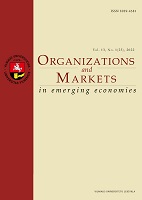Intention to use Peer-to-Peer (P2P) Lending: The Roles of Perceived Structural Assurance and Perceived Critical Mass
Intention to use Peer-to-Peer (P2P) Lending: The Roles of Perceived Structural Assurance and Perceived Critical Mass
Author(s): Hanif Adinugroho Widyanto, Jhanghiz Syahrivar, Genoveva Genoveva, Chairy ChairySubject(s): Business Economy / Management, Political economy, Economic development, Socio-Economic Research
Published by: Vilniaus Universiteto Leidykla
Keywords: P2P lending; perceived critical mass; perceived structural assurance; continuance intention to borrow; TAM;
Summary/Abstract: Peer-to-Peer (P2P) lending platform has enormous potential to improve financial inclusion for people in emerging countries. In this regard, the present study examined the predictors of continuance intention to borrow from P2P lending, especially as a Multi-Sided Platform (MSP) that relied heavily on critical mass to succeed. This research was among the first that analyzed the behavioral intention of P2P lending from the borrower’s perspective by expanding on the technology acceptance model (TAM) with two fundamental latent constructs for MSPs, namely perceived structural assurance and perceived critical mass. This quantitative study used Partial Least Square Structural Equation Modelling (PLS-SEM). Online questionnaires were spread to P2P lending borrowers (n =174) from all over Indonesia to measure the latent constructs. The result revealed that all the exogenous constructs did not have direct relationships with continuance intention to borrow. However, perceived structural assurance and perceived ease of borrowing indirectly affected the endogenous construct through perceived usefulness as the mediating variable. This study also offers some managerial implications for the P2P lending industry.Intention to use Peer-to-Peer (P2P) Lending: The Roles of Perceived Structural Assurance and Perceived Critical MassPeer-to-Peer (P2P) lending platform has enormous potential to improve financial inclusion for people in emerging countries. In this regard, the present study examined the predictors of continuance intention to borrow from P2P lending, especially as a Multi-Sided Platform (MSP) that relied heavily on critical mass to succeed. This research was among the first that analyzed the behavioral intention of P2P lending from the borrower’s perspective by expanding on the technology acceptance model (TAM) with two fundamental latent constructs for MSPs, namely perceived structural assurance and perceived critical mass. This quantitative study used Partial Least Square Structural Equation Modelling (PLS-SEM). Online questionnaires were spread to P2P lending borrowers (n =174) from all over Indonesia to measure the latent constructs. The result revealed that all the exogenous constructs did not have direct relationships with continuance intention to borrow. However, perceived structural assurance and perceived ease of borrowing indirectly affected the endogenous construct through perceived usefulness as the mediating variable. This study also offers some managerial implications for the P2P lending industry.
Journal: Organizations and Markets in Emerging Economies
- Issue Year: 13/2022
- Issue No: 1
- Page Range: 183-208
- Page Count: 26
- Language: English

